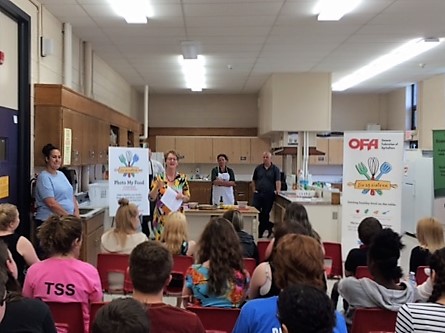|
By: Joyce Parslow, P.H.Ec., Director Consumer Relations, Canada Beef
Canadian beef is world-class in quality and availability. Beef is raised in each and every province. Cattle feed on grass and forage for the most part with a blend of grains such as barley, wheat or corn mixed-in as they reach maturity. Breeds and feeds give Canadian beef the flavour and tenderness you expect in a great steak. Making the Grade: Canadian beef bought in-store is federally or provincially inspected for safety – no compromises. The best in beef is given an 'A' GRADE quality designation. Just as in hockey, look for Canada AAA as the top in the league, followed by double A (AA) and then single A. Shopping Simplified: Canadian steaks are sorted into three basic cooking categories. Package labels identify the cut and the recommended cooking method (e.g. Top Sirloin grilling steak, Flank marinating steak). Grilling Steaks are ever tender – simply season and sear; Marinating Steaks are best marinated before grilling, but require advanced planning. These steaks often have the boldest beefy flavour and can be value-priced; Simmering Steaks are not BBQ steaks – best simmered low and slow in a winter stew. TIPS to ensure no mis-steaks:
Cedar Planked Steak with Charred Garden Salsa (from the Canada Beef Test Kitchen) Cooking steak on a cedar plank imparts fantastic wood-smoke flavour reminiscent of deli-smoked meat. Here, the marinade doubles as the base for the fresh salsa – just be sure to *remove what you need for the Salsa, before using the remainder to marinate the meat. Marinade/Dressing 1-3/4 cups (425 mL) barbecue sauce (your favorite brand) 1/4 cup (50 mL) lemon juice 2 Tbsp (30 mL) prepared horseradish 6 sprigs fresh rosemary (leaves only) coarsely chopped 1 Flank Marinating Steak or Top Sirloin, about 1-1/2 lb (750 g) Sea salt and freshly ground pepper Cedar Plank 1 can or bottle (440 mL) beer Vegetable oil Salsa 2 cups (500 mL) grape tomatoes 8 cloves garlic, peeled 4 ears of fresh corn, husked 4 green onions, trimmed 1 EACH sweet yellow and sweet red pepper, seeded, cut into large chunks 2 Tbsp (30 mL) vegetable oil Sea salt and freshly ground pepper 1. MARINADE: In large re-sealable freezer bag, combine barbecue sauce, lemon juice, horseradish and rosemary. * Remove 1/2 cup (125 mL) and set aside for Salsa. Pierce steak all over; place in bag with marinade. Seal.Refrigerate for 2 hours or up to 24 hours.Soak plank for at least 2 hours in enough beer and warm water mixture to cover, weighing down with heavy jars to submerge. 2.Heat plank in closed barbecue over medium-high heat until plank crackles and smokes, about 3 minutes. Brush top side with oil. Remove steak from marinade. Pat dry with paper towel; discard used marinade. Season both sides with salt and pepper. Place on plank. Cook in closed barbecue, without turning until digital instant-read thermometer reads 145°F (63°C) for medium-rare, about 15 minutes. Remove steak from plank. Let rest for 10 minutes before carving across the grain into thin slices. 3. SALSA: Alternately thread grape tomatoes and garlic onto soaked wooden skewers. Brush vegetables all over with oil and season with salt and pepper. Grill over medium-high heat in closed barbecue, starting with corn, until charred all over, turning occasionally. Let cool slightly. Cut kernels from cobs. Coarsely chop remaining vegetables. Combine with reserved barbecue sauce mixture. Serve with steak. Makes 4 to 6 servings
0 Comments
High school students, local politicians and industry partners took part in a unique food literacy classroom demonstration May 25, 2016 to learn about the new SixbySixteen.me resource and find out about a new Photo My Food social media contest.
SixbySixteen.me – a site developed by the Ontario Federation of Agriculture (OFA) – took over the nutrition class of Grade 10 students at Thorold Secondary School in Thorold, Ontario. Students watched a cooking demonstration and presentation by Chef Derek Roberts of Fraberts Fine Foods in Fergus, and learned about the resources available on SixbySixteen.me that help young people learn how to cook, find local food and make healthy choices for lifelong health. Michele McAddo, P.H.Ec spoke to the group about the importance of this new initiative in improving food literacy. Cindy Hartman, P.H.Ec. and Carolyn Frail, P.H.Ec. were also at the event representing OHEA. For more information about this initiative, visit www.sixbysixteen.me by Marnie Webb, P.H.Ec. Listeriosis is an infection caused by eating food contaminated with the bacterium Listeria monocytogenes. Although rare, pregnant women are twenty times more likely than other healthy adults to get listeriosis. Healthy food choices and safe food practices protect mother and baby, contributing to a healthy pregnancy. Hormonal changes during pregnancy affect the immune system, causing pregnant women to become more susceptible to foodborne illness. While serious, foodborne risks for pregnant women can be addressed by handling food properly and by avoiding certain foods. Foods to avoid include:
Listeriosis infections during pregnancy can lead to miscarriage or stillbirth, premature delivery, or infection of the newborn. Pregnant women may only experience a mild illness. Symptoms of listeriosis usually appear within 2 to 30 days but have been known to occur up to 90 days after eating contaminated food. Listeria is prevalent in the environment. It is found in soil, water, vegetation, human and animal feces. In some processed foods like deli meats, contamination may occur after cooking but before packaging. Listeria may be present in all foods. Listeria can survive and grow slowly at refrigeration temperatures. Listeria will grow faster at refrigerator temperatures above 4°C (40°F). You cannot tell by the look, smell or taste if listeria is present in food. Listeria is killed by cooking food. To reduce the risk of developing listeriosis:
Pregnant women with questions or concerns about listeriosis are advised to consult with their health care provider. by Mary Carver, P.H.Ec. Families today need home economics skills as much as they did a century ago when Adelaide Hoodless declared 'a nation is only as strong as its homes and families.' Home economics is an interdisciplinary field of study — the sum of its parts: nutrition, food preparation, consumer education, financial management, clothing and textiles, interior design, child development, relationships and sustainability. Re-branded as family studies in high schools and as human ecology at universities, course values remain true to home economics roots and central to the well-being of families. A home economics movement A growing number of people seek a healthier lifestyle, farmers’ markets, slow-food, improved fitness and better mental health. They read food labels, avoid fad diets, shop local and buy fair trade. They’re socially responsible consumers and are concerned about global food and water security. They respect time-of-day energy use and minimize waste. This is home economics. However, families are less-healthy and carry more household debt than ever before. Dining out frequently and buying packaged food is costly to our health and budgets. We are major consumers that appear to manage time and purse strings with difficulty. In December 2013, Statistics Canada reported that Canadians owed $1.64 for every dollar earned. Common family challenges
Looking forward A zealous demand for organic food, community gardens, and home canning are indicators that not all families crave fast-food. That said, at least one generation has already grown-up without learning how to cook. Follow these tips to achieve and maintain a desirable quality of day-to-day life
Some families romanticize a healthier, back-to-basics lifestyle; others struggle to achieve it, due to a lack of skill or opportunity.
Mandatory food literacy (nutrition and food preparation skills) may help to reduce risks of obesity, type II diabetes, heart disease and unnecessary stress on family finances (read our latest media release here - Food Literacy ~ A Lifelong Commitment) In 2013, the Ontario Ministry of Education released several ‘new’ family studies courses. Students should check high school option sheets for food and finance choices. Carolyn Frail, P.H.Ec. The Board of Directors of the Ontario Home Economics Association (OHEA) is pleased to announce the appointment of Carolyn Frail, P.H.Ec. as Association Coordinator.
A graduate of Ryerson University, with a BASc in Food and Nutrition, Frail is a Toronto-based Professional Home Economist with over 15 years of diversified experience in food and nutrition freelance writing, proposal writing, project management, strategic planning, consulting, sales and marketing for both profit and not-for-profit organizations. Carolyn’s background includes work for the Women’s Culinary Network, the Oat and Barley Council of Ontario, the Ontario Food Protection Association, Chapters, CIBC, President’s Choice Financial, and most recently Taste Canada – The Food Writing Awards. Embracing a passion for family, health and fitness, Carolyn lives in the Beaches neighbourhood of Toronto with her husband and their two children. Frail begins her full time positon with OHEA on May 11, 2016 and will leverage her experience and leadership skills to advance OHEA’s vision, support members, reach out to like-minded groups and dispatch OHEA messages to consumers. Carolyn Frail, P.H.Ec., can be reached at: [email protected] By Mary Carver, P.H.Ec. In an ideal world, food education would begin in the home, be expanded throughout each grade in school and become a lifelong interest for all. Teaching young people to make nutritious food choices and giving them hands-on kitchen skills to create meals from scratch prepares them to lead healthy, independent lives – ultimately within a budget as they become ‘the breadwinners’ of tomorrow. But who is providing food education? Some parents tell us they “don’t have the time or patience – don’t want the mess – can’t cook (themselves) – or are too confused by conflicting nutrition messages,” to teach their own children to cook from scratch. Perhaps grandparents can help? A November 2015 survey by Montreal-based Léger Marketing identified that meal preparation tends to be a last-minute task, with 65% of Canadian households deciding between 4-5 pm what’s for dinner tonight. Clearly, weekly menu planning is not routine for every family. A lack of time is the culprit on many fronts. Two income families or single parents run in multiple directions. Most have evening chores, laundry catch-up, elderly parents to assist, homework to supervise. Meetings. Time to teach their kids to cook may not even be on their radar. Parents tell us that just to sit down as a family at meal time can be a luxury. Due to extended work hours and long commute times, family meals have changed. Frequent snacking has replaced (or expanded) the traditional 3 meals per day around the kitchen table. And more people eat alone at their desks. Yet, parents do have an important role to play in supporting their child’s learning.“Although the causes of obesity are complex, families have significant influence on children’s dietary habits and weight and should be involved in planning healthy living campaigns and efforts to curb food marketing that targets children,” says Dr. Barbara H Fiese, PhD., Professor, Human Development & Family Studies, University of Illinois. So what happens if kids don’t learn to cook? They can grow up to be parents and role models who can’t cook. And the cycle repeats. They eat out of the home, often. They choose a diet of fast or highly-processed food and prepared entrées - often with low intakes of fruit, vegetables, and whole grains. And do kids have the skills to choose the healthier options when they eat out or do they simply surrender to the marketing geared to them? “Poor nutrition has adverse impacts on health, and increases the economic and social burden of chronic disease in Ontario,” reports the Ontario Public Health Association. Higher levels of sugar, sodium and fat in most prepared and processed food along with super-sized portions may be responsible for more health problems than we can count. We hear repeatedly that obesity, Type II diabetes, and hypertension are on the rise in all age groups. Meanwhile, “fatty liver is a new epidemic,” says Dr. Linda Scully, a liver specialist at the Ottawa Hospital. “1 in 4 Canadians may be affected by liver disease due primarily to the rapidly rising prevalence of fatty liver disease linked to obesity, lack of physical activity and poor eating habits,” reports the Canadian Liver Foundation. Food literacy is a matter of having sufficient nutrition knowledge to make smart, affordable choices, enough time and cooking skills to prepare tasty, locally-sourced food from scratch, a commitment to reduce food waste and a respect for one’s health and safety. It requires knowledge and skills and takes planning and practice. In April 2016, a $60 million “renewed math strategy” was announced by the Ontario Ministry of Education. Teachers scramble to improve provincial math scores. The Ontario Home Economics Association (OHEA) and other like-minded groups, think food literacy is equally important. Yes, math is a critical requirement for most jobs; but food is a necessity of life. Age-appropriate cooking skills are woven throughout the curriculum in schools in Japan. Could Ontario students not benefit from the same health opportunity? A number of students already earn credits for food and nutrition courses offered through Family Studies curriculum in Ontario high schools, but, these excellent courses are not compulsory. Therefore, many kids miss out. Home Economists are concerned. Let’s inspire our youth to get in the kitchen and cook real food. OHEA has a growing online petition, with over 3100 signatures, to encourage the Government of Ontario, to make at least one food and nutrition course mandatory for all Ontario students. Sign the petition at: www.food-literacy.ca The Ontario Federation of Agriculture (OFA) is challenging families with a unique Six by Sixteen initiative. The goal is for youth to learn to cook six meals by 16 years of age. OHEA supports the project and its potential outcomes. OFA, in collaboration with its many partners, is posting simple learn how to cook videos using local, seasonal food on their website. Learn to make an omelette, turkey meatballs, to chop an onion or measure ingredients accurately, for example. May 20, 2016 is Food Revolution Day – “a day of global action that celebrates wholesome, fresh, food – a day of sharing the power of cooking,” says Chef Jamie Oliver, famous for his food education efforts. “Let’s celebrate and learn together.” Ontario Professional Home Economists encourage parents, and youth to tap into the above resources, to commit to family meal time and to enjoy the abundance and variety of food readily available within our agriculturally-rich province. We owe it to our kids and grandkids to make a ‘real’ food literacy commitment for life! -30- Mary V. Carver, P.H.Ec. is an Ottawa-based Professional Home Economist and Food Literacy Coordinator for the Ontario Home Economics Association.
Ontario Home Economics Association (OHEA), a self-regulated body of Professional Home Economists, promotes high professional standards among its members so that they may assist families and individuals to achieve and maintain a desirable quality of life. For further information, please contact: Ontario Home Economics Association, 1225 Meadowview Rd., RR #2 Omemee, ON K0L 2W0 Phone: 705-799-2081 / Email: [email protected] / Website: www.ohea.on.ca and www.food-literacy.ca |
The Ontario Home Economics Association, a self-regulating body of professional Home Economists, promotes high professional standards among its members so that they may assist families and individuals to achieve and maintain a desirable quality of life. Categories
All
Archives
April 2024
|
|
Subscribe to our mailing list
|
|
Unsubscribe from our mailing list
|
Copyright © 2023 Ontario Home Economics Association (OHEA). All Rights Reserved.




 RSS Feed
RSS Feed